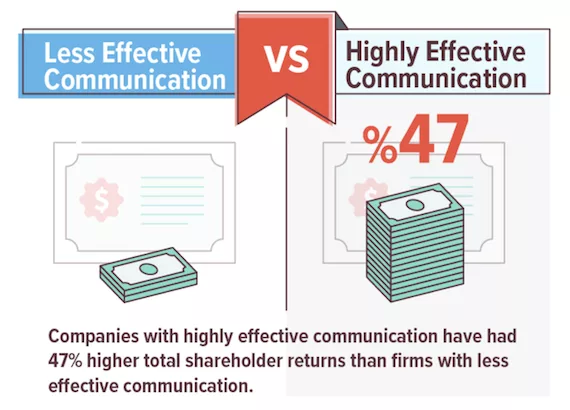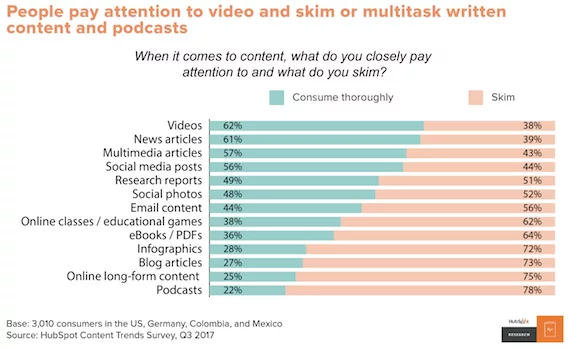If employees are happy at their workplace, it is reflected in the company's success. Effective internal communication is a decisive success criterion. In this article, you will learn what role videos play and how you can use them to create a feel-good corporate culture full of creativity.
No desire to read? Listen to the blogcast:
Jump quickly to the appropriate section:
Videos are on everyone's lips with advertisers, and they take up a lot of their time. When we talk about videos in business, we usually mean commercials, image films, or product videos. The main focus is clearly on external communication. Everything revolves around how a brand presents itself to the outside world, what sets it apart from the competition, and how a close relationship with the target group can be established.
Our tunnel vision is to blame for the fact that we, unfortunately, completely disregard other uses and locations for videos. These possibilities are just as important for the company.
One area that definitely deserves more attention is internal communication. This may come as a surprise for some, but for us, it’s clear: A company is only as good as its employees. Therefore, the biggest investment should be in the staff.
Employee satisfaction is an issue that has long since ceased to concern only the human resources department. The internal communications department also plays a role.
Employee Commitment Should Be the Main Driver.
Employee commitment is the level of commitment, passion, and loyalty an employee brings to his or her work and company. The more committed an employee is, the more work he or she will do.
Human resources professionals, communications professionals, and business leaders are dedicated to raising the level of commitment, passion, and loyalty of their employees. Employee satisfaction comes first.
What makes a coworker satisfied? Corporate psychologist Dr. Ritika Srivastava has a clear opinion, stating, “Communication is the cornerstone of an engaged workforce.” She describes the importance of transparent communication within an organization so that employees feel they are valued members with a voice.
According to the Communication ROI Study Report, companies with exemplary internal communication achieved a 47% higher return on investment in the last five years than companies with less effective communication.

“Effective internal communication is the key to business success,” according to, "Willis Tower Watson’s Communication ROI Study Report".
By now, you should realize that excellent corporate communication creates satisfied employees. They, in turn, are more committed to their work, thus, helping the company achieve more growth and profit.
In theory, that sounds nice. In practice, however, a different picture emerges. In a study by HRN Europe, employees stated that "Employee Engagement" is one of their top five challenges in the workplace. This is illustrated by the results of the Gallup's State of the Global Workplace Report. Only 13% of employees said they felt committed to their work.
This raises the question: How do you increase employee engagement potential?
It's time for internal communication to think about something. It takes the attention of the entire workforce and the right message to get everyone going in the same direction. This now raises new questions: What is the most suitable channel? How can we best feed it with content?
Don't worry about it any longer because we present to you the solution on a silver platter – videos! How did we get this idea? Read on here!
Video Acts As a Trailblazer.
Hollinger and Scott interviewed communication experts about the most popular communication channels in the company. In response, they received e-mails, intranet, and meetings, among other things. The problem with these channels, however, is that they no longer work well enough these days. Personal meetings aren't practical for global players, posters and banners aren't exciting enough for busy employees, and text-based email can get lost quickly in crowded mailboxes.
A new creative approach is needed! Animated moving images are on the rise! It changes the way we communicate and consume content.
On an ordinary day, consumers watch an average of 1.5 hours of video (15% of people watch over 3 hours), and the trend is rising. A Cisco study even predicted that mobile video traffic will account for 75% of all mobile data traffic by 2020.
Text is out, moving image is in. In this way, consumers can ensure that they will not be overwhelmed by the furious flood of information. Videos defuse the situation. They make it easier to record information in the shortest possible time without overtaxing their own brain performance. Entertainment through videos gives further added value.
As a result, videos are often viewed in great detail, while written content and podcasts are only glanced over.

Content identified by Hubspot that receives the most attention
Videos don't stop at internal corporate communications either.
Gatehouse's HR experts confirm this trend by predicting, "We expect many of the best intranets to be largely built around video in the coming years.” Furthermore, 75% of executives stated that they watch videos related to their work at least every week.
Video has not only become the preferred form of communication in private life, but is also well received in daily business. It is only natural that videos should also be used as a proven tool in communication with employees.
Speaking of use, videos can follow various internal functions. They all serve the overall goal of employee engagement, but the focus can still be different. See for yourself!
Achieve These 4 Milestones with Video.
In order to establish a highly effective corporate communication, these four milestones can help achieve the former.
#1 Mobilizing the Masses.
First, you need to make your voice heard to the entire workforce, and then recruit animators. People are herd animals by nature. If one begins, all others follow along.
The more people get wind of a thing, the better. News and other announcements can spread like wildfire within a short time.
Videos are perfectly suited for this purpose. Just by including the word "video" in the email subject line, the opening rates increase by an incredible 19%. You can ensure that all employees receive the email at the same time or at a time that suits them. You can also display your video on monitors in the building, on the homepage of your website, in shops, and on screens at trade shows.
You can trigger a real viral wave within the company – possibly even at an international level. Above all, you need to make sure everyone has access, but with the latest technologies, that shouldn't be a problem!
Daimler CEO, Dr. Dieter Zetsche, sent a video message to all his employees thanking them for a successful business year and wishing them continued success. When the most important person in the company has something to say – personally stepping in front of the camera, making fun of himself – it naturally causes a sensation.
Dr. Dieter Zetsche of Daimler thanks his colleagues at the end of 2017.
#2 Creating an Internal Community.
In addition to our herd instinct, people are characterized by a strong desire to feel that they belong to a social group. Our motto is, "Sharing is caring.” This is also reflected in our online consumer behavior. 92% of users who watch a video with a mobile device will share it.
With the help of video, you can strengthen the sense of community. For example, you can announce or present nominations for awards or social projects. Which person, which team is behind it? They can then speak for themselves and share their views.
This gives your staff the opportunity to work together for a cause, to drum up the publicity and support each other in their projects. Those who show special commitment receive praise and recognition.
Example pleasing?
Merck has relaunched its brand. The change process was documented in a video and later published. This video recorded what the brand change meant for the company, how it was managed, who was involved, and what successes could be achieved.
Merck is one of the showcase companies that has managed to intensify the cohesion among its employees. This internal branding campaign could only be mastered collectively. Above all, the work of the Brand Champs was placed in the foreground. Their task was to pass on the new values to their colleagues and to integrate the new brand thinking into everyday corporate life.
This is how Merck's internal branding campaign was rolled out.
#3 Promoting Corporate Learning.
The greatest need of people is self-realization. They want to put their wishes, dreams, and plans into practice and be excellent at what they do in their work.
The company's responsibility is to set the course. Employees must have everything they need to do their job as well as they can and find fulfilment in it.
Knowledge is power and know-how brings the decisive competitive advantage. Therefore, knowledge transfer in the form of employee training, workshops, and annual meetings is all the more important. Employees need to know about current plans and developments in order to be able to act effectively.
Time is money! Inform and train differently – creatively, entertainingly, visually, and time-savingly. Did you know that the majority of employees (78%) already watch videos weekly? 55% even consume videos daily.
Take the opportunity and communicate important topics via video. Have you already thought about e-learning programs? Meaningful topics could be about the induction of new employees, the demonstration of optimized operating systems, or the presentation of new strategies.
In order to promote learning on a large scale, you should make the videos available on a central platform, preferably online and/or on the intranet. A la Video on Demand, team members can then view the teaching content when and where they want. All at your leisure, without having to leave your desk or home office.
#4 Introducing Your Opinion-Count Mentality.
Es kann nicht immer alles rund laufen. Dafür ist es aber umso wichtiger, dass sich das Unternehmen um eine Besserung der Situation bemüht und das gesamte Kollegium bei der Lösungsfindung mit einbezieht. Mitarbeiterumfragen und -gespräche werden deswegen oft und gerne genutzt.
Everything can't always run smoothly, but it is all the more important that the company strives to improve the situation and involves the entire staff in finding solutions. Employee surveys and discussions are often and gladly used.
Employees want their feedback to be heard, but that's not all. They are hoping for a two-way dialogue between them and management. For them, being allowed to have a say and it be valued is, ultimately, the recognition that ensures satisfaction in the workplace.
Having an opinion is one thing. Having the courage to say it out loud is quite another. It is, therefore, important to create a safe place where everyone can express their views freely.
In the MetrixLab example, a real film is used to encourage employees to give feedback to the company as part of an employee satisfaction survey. In order to increase the number of participants, the company receives support from committed employees calling on their teammates to participate in the survey. Who can say no?!
MetrixLab invites colleagues to participate in its annual employee satisfaction survey.
It should be clear, by now, what videos can achieve. The next step is to take a closer look at 3 popular video forms, which should serve as inspiration for you.
3 Examples of Popular Video Forms in Internal Communication.
In the following, we would like to introduce you to our top 3 video types in internal communication, identified on the basis of our experiences and recent observations in the video industry.
#1 How-to Videos & Process Videos.
- What: Demonstrating how to perform a particular task.
- How: Step-by-step instructions
- Advantage: Employees who need to know new processes/products can watch the repetitions as often as they want and learn them; the company saves time and money on learning and training.
On Clickup's YouTube channel, you will find countless How-to videos on various topics. New features are introduced, how to make different settings, how to manage teams, and how to use Clickup as a SAAS tool in general. These videos can be used by customers as well as by employees for further training.
Clickup explains the function Task Checklist.
Tip:
Screen Capture Videos are ideal for live demonstrations of a software, website, or app. They appeal to visual learners and, obviously, demonstrate the added value for the user. Try it out!
#2 Explainer Videos.
- What: Address (complex) issues that need explanation.
- How: To identify the do's & don'ts, to set up rules, to offer a solution for problems/needs, and to name advantages
- Advantage: Provides clarity and greater understanding
In the Bayer case, the video is used to show employees what is allowed and what is not allowed in dealing with colleagues. Animated drawings convey a dry topic vividly.
Bayer makes its compliance policy clear.
Tip:
Animated Explainer Videos limit themselves to the essentials in order to present generally more complex things in a simple and understandable way. Play with different video styles, such as Graphy, Indy, or White Board, to provide entertainment, despite the toughness of the topic.
#3 Internal Webinars.
- What: Trainings, workshops, and lectures.
- How: Interactive speaker asking questions and receiving answers and feedback from the audience via live chat.
- Advantage: Different people from different areas in different places, and, with the help of different devices, can participate, discuss, and come together to a solution; if employees cannot participate, the webinar is recorded and made available in an online library for later retrieval (see playlist).
In today's world of digitalization and international corporations, webinars, without discussion, are part of successful employee management and effective process design.
The GoToWebinar video shows how easy it is to organize a webinar yourself. With it you get everyone at the table!
With GoToWebinar you can create, announce, and stream a webinar.
Do you want to delve deeper into the topic of eLearning and webinars? Then we recommend our article "eLearning per Video: How to Revolutionize Learning in Your Company.”
We understand what it’s like when your fingertips are tingling with anticipation to create your first video. Use our blog to help you get started. There you will find helpful, practical tips and examples, saving yourself from beginner's mistakes!
Make Your Company Strong.
According to Wordsream, 59% of executives prefer videos instead of reading a text on the same topic. In addition, users can remember an incredible 95% of a message when it's packaged in a video. A message conveyed within a written text, on the other hand, can only be remembered at a paltry 10%.
Does there need to be an end to tedious annual reports, marketing plans, and boring company presentations? Yes! Businesses should communicate efficiently with videos!
Go ahead and realize your personal video project today. Would you like more support with the implementation? We will be happy to advise you free of charge and without obligation »

